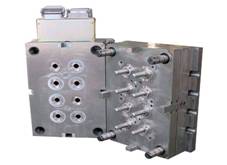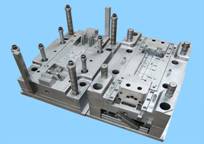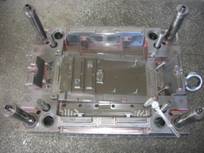| The basic knowledge of plastic mold design |
| PublishTime:2018-07-06 Click:3900 |
1. Design basis The accuracy of dimensional accuracy and its related dimensions. According to the specific requirements and functions of the whole product of plastic products, the quality and size of the products should be determined: Plastic products, such as toys, which require higher appearance quality and lower dimensional accuracy requirements; Functional plastic products with strict size requirements. Plastic products, such as cameras, are very strict in appearance and size. Whether the stripping is reasonable. The release angle is directly related to the ejection and quality of plastic products, that is, whether the injection can be carried out smoothly during the injection process: The demoulding slope is sufficient; The slope should be in accordance with the moulded or parting surface of the plastic products; whether it will affect the accuracy of the appearance and the thickness of the wall. The demoulding slope is sufficient; The slope should be in accordance with the moulded or parting surface of the plastic products; whether it will affect the accuracy of the appearance and the thickness of the wall. Whether it will affect the strength of a part of the plastic part.
2. Design program Analysis and digestion of plastic products and entities (solid samples): A, the geometric shape of the product; B, dimensions, tolerances and design benchmarks; C, technical requirements; D, plastic name, brand E, surface requirements The number of the cavities and the arrangement of the cavity: A, weight of products and injection quantity of injection machine; B, the projected area of the product and the clamping force of the injection molding machine; C, the size of the mold and the effective area of the injection mould, or the distance between the drawing rods. D, product accuracy and color; E, products with or without side core and their treatment methods; F, production volume of products, G, economic benefits (production value per module) After the number of the cavity is determined, the arrangement of the cavity, the arrangement of the cavity position, the arrangement of the cavity, the design of the gating system, the balance of the gating system, the design of the core (slider) mechanism, the design of the insert and the core, the design of the heat exchange system, and the above problems are also with the type and gate. The location is related to the selection, so in the specific design process, we need to make necessary adjustments to achieve a more perfect design. 3. Determination of the parting surface It does not affect the appearance; It helps to ensure product accuracy and mold processing, especially the machining of cavity. It is beneficial to the design of gating system, exhaust system and cooling system. It is advantageous to open the mold (parting and demoulding) to ensure that the product is kept on the side of the moving die when the mold is opened. Facilitate the arrangement of metal panels.
4. Design of the gating system The design of the gating system includes the selection of the main channel, the determination of the shape and size of the section of the diverting channel, the selection of the gate position, the gate form and the determination of the size of the gate section. When using the point gate, the design of the dewatering device and the nine chapter gate mechanism of the dewatering device should be paid attention in order to ensure the separation of the runner. When designing gating system, the location of gate is first selected. The choice of gate location is directly related to the molding quality and the smooth operation of the injection process. The location of gate should follow the following principles: (1) gate location should be selected on the parting surface as far as possible, so as to facilitate the cleaning of the gates when the mold is processed and used. (2)The distance between gate location and all parts of the cavity should be the same as possible and make the process shortest. (3)The location of the gate should ensure that when the plastic flows into the cavity, the cavity will be smooth and thick, so that the plastic will flow smoothly. (4)The gate position should be located at the thickest section of the plastic section. (5)The plastic wall, core or insert can be directly directed into the cavity when the plastic cavity is flowing down, so that the plastic can flow into the parts of the cavity as quickly as possible and avoid the deformation of the core or the insert. (6)As far as possible avoid making the product produce weld mark, or make the weld mark produce the unimportant part of the product. (7)The position of the gate and the direction of the plastic inflow should make the plastic flow in parallel in the direction of the cavity, which is beneficial to the discharge of the gas in the cavity. (8)The gate should be placed on the wiping part of the product, and at the same time, it will not affect the appearance of the product as far as possible.
5. Design of exhaust system The exhaust system plays a vital role in ensuring the molding quality of products. A, using the exhaust slot, the exhaust tank is generally located at the end of the cavity, and the depth of the exhaust slot varies with the plastic. It is basically determined by the maximum clearance allowed by the plastic does not produce the flown. For example, the ABS 0.04 is less than 0.02 of the race steel below the peat 0.02mm. B, make use of core insert, push rod and other matching clearance or special exhaust plug exhaust; C, and sometimes, in order to prevent the vacuum deformation of the product when ejecting, there must be a gas pin. D, and sometimes designed to prevent vacuum adsorption of products and modules, and design anti vacuum adsorption components. 6. Design of cooling system The design of the cooling system is a relatively complex work, that is to consider the cooling effect and the uniformity of cooling, and to consider the influence of the cooling system on the overall structure of the die. The arrangement of cooling system and the specific form of cooling system. The determination of the specific position and size of the cooling system; The cooling of the key parts such as the moving die or the insert. The cooling of the side slider and the side core. The design of cooling components and selection of cooling standard components. Seal structure design. |











